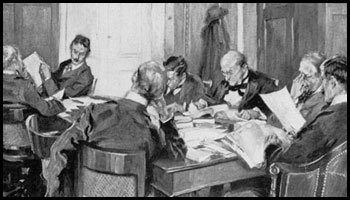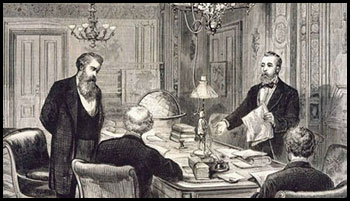On December 10, 1816, the Senate approved a resolution, introduced by Senator James Barbour of Virginia, creating 11 permanent, standing committees. Since that time, committees have steadily evolved, growing in influence and importance. Today, committees are an integral component of the Senate, allowing senators to fulfill their many responsibilities with more knowledge and efficiency.

The Constitution does not contain the word "committee," but both the Senate and the House of Representatives have used committees since the very first Congress. The Senate attained its first quorum to conduct business on April 6, 1789, and immediately went to work counting electoral ballots and declaring George Washington as the nation's first president. The next day, April 7, the Senate created its first two committees. A committee of five members tackled procedural issues, such as compiling rules, selecting a chaplain, and conferring with a House committee to establish a conference process. The other, an eight-member committee, was instructed to "bring in a bill for organizing the Judiciary of the United States." Once they completed their assigned duties, however, the committees were dissolved. The Senate relied upon this ad-hoc committee system for the next 27 years.
Ad-hoc committees reported to the Senate acting as a Committee of the Whole, a system that was well suited to the small Senate of the early years. When an issue arose, the Senate formed a committee to address it. Such committees tackled nominations, treaties, and day-to-day legislative matters. When a senator wished to introduce a bill, he notified the Senate and members debated the proposal. If senators approved of the idea, a committee was created to study the matter further, with its members selected by ballot. Only those favoring the bill served on the committee, and the senator who gained the most votes served as chairman.
When the president sent his annual message to Congress (now the State of the Union Address), the report was divided by subject area and a committee was formed to address each section. This resulted in hundreds of short-lived committees that were created and then terminated during the Senate's first quarter century. Only four committees gained a semi-permanent status prior to 1816—three joint committees for bicameral housekeeping and the Committee to Audit and Control the Contingent Expenses of the Senate.

As the Senate's workload increased, individual senators built an expertise in certain legislative areas. Senator Oliver Ellsworth, for example, a delegate to the Constitutional Convention and later Chief Justice of the United States, sat on most committees considering judicial matters. Senator Robert Morris, a wealthy merchant and financier, often led the way on commerce and trade. Western senators studied land claims, while northern senators looked to issues of manufacturing. This committee system was flexible and responsive to immediate needs, but too often it resulted in committee work being unevenly distributed. While some senators rarely served on a committee, others were simply overwhelmed by such duties. During the 9th Congress of 1805-1807, for example, Georgia senator Abraham Baldwin served on 91 separate committees, even though the average among his colleagues was closer to 20.
The crisis of war with Great Britain between 1812 and 1815, including the burning of the Capitol in 1814, prompted the Senate to reexamine its committee system and the need for stability and continuity. The increasing number and complexity of the Senate's legislative responsibilities demanded a division of labor and degree of specialization that went beyond the capabilities of the ad-hoc committee system. When the second session of the 14th Congress opened in December of 1816, with the Senate meeting in temporary headquarters after the fire, senators received President James Madison's annual message. Instead of creating a host of select committees to address each issue, however, on December 5, 1816, Senator Barbour submitted his proposal to establish 11 standing committees: 1) Foreign Relations, 2) Ways and Means, 3) Commerce and Manufacturers, 4) Military Affairs, 5) Militia, 6) Naval Affairs, 7) Public Lands, 8) Claims, 9) Judiciary, 10) Post Offices and Post Roads, and 11) Pensions. On December 10, 1816, the Senate approved Barbour’s resolution with one minor revision—dropping the "Ways and Means" title in favor of a Committee on Finance.

The establishment of permanent standing committees was a pivotal moment for the Senate, as it further empowered committees and their members to influence legislation, provide long-term oversight, enable ongoing consideration of complex treaty negotiations, and conduct a more thorough deliberation of presidential nominations. "Pray, sir, what is the object of referring a bill to a committee—merely to dot the i’s and cross the t’s?" asked Senator Barbour. "I had supposed they had a more important duty to perform … their bounden duty to modify or amend any and every part in relation to the particular subject embraced by the bill." A shift in authority and responsibility also followed the creation of permanent standing committees. Instead of the Senate telling its committees what to put into legislation, as it had done in the years prior to 1816, committees assumed the prerogative of determining which substantive provisions the Senate should consider, with chairmen leading the way. Committees became policymaking bodies rather than mere procedural aids to the full Senate.
Those original 11 committees have evolved into today’s 16 standing committees, four special or select committees, and four joint committees, which play a crucial role in fulfilling the Senate’s constitutional and policymaking duties.